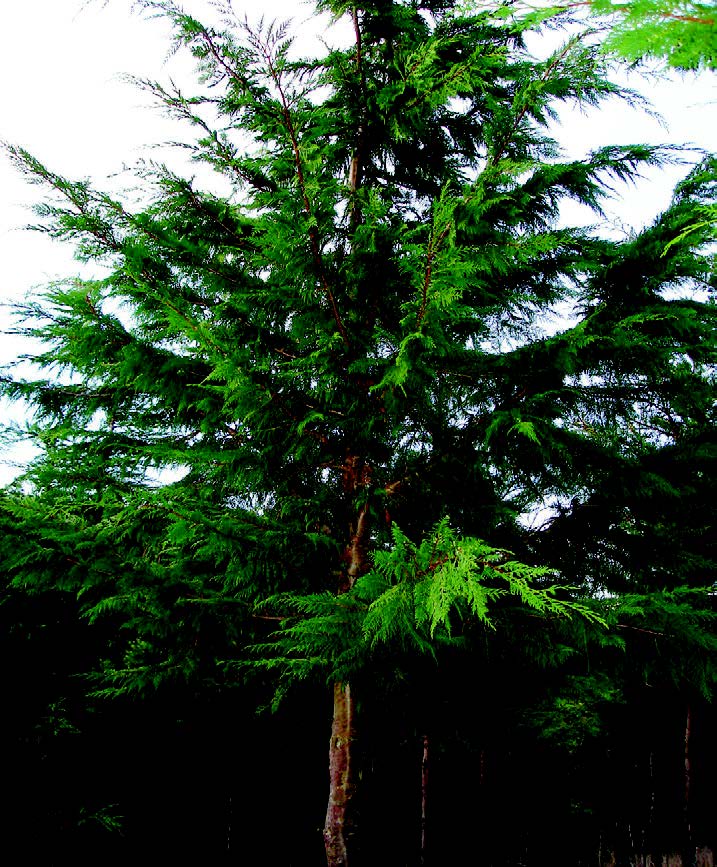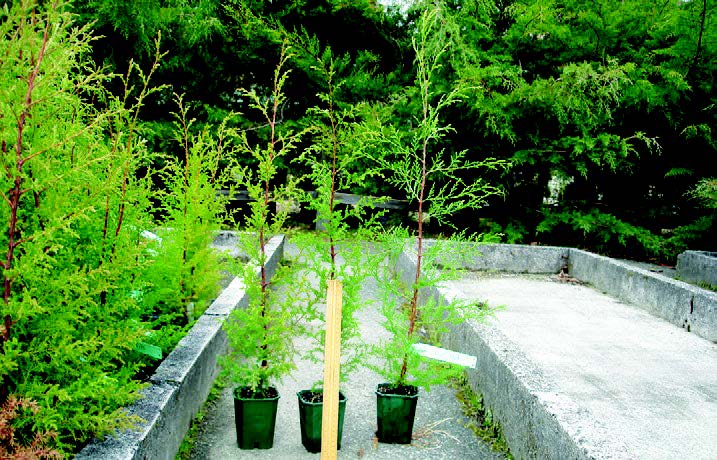Cypress hybrids
Charlie Low, New Zealand Tree Grower February 2010.
Hybrids occurring naturally between cypress species can offer commercial advantages over either of the parent species. Some accidental inter-genus hybrids such as Leylands and Ovensii have been vegetatively deployed for over a century. Scion is taking a more deliberate approach to cross-pollination to explore the commercial potential of cypress hybrids as part of a Future Forests Research programme.
A large group
The term cypress refers to quite a number of genera in the group Cupressacea each containing a number of distinct species. The species that are commonly used to produce cypress timber in New Zealand are confined to two genera, Cupressus and Chamaecyparis. The main cypress species identified for New Zealand forestry are Cupressus lusitanica and C. macrocarpa.
Breeding programmes for each of these species have been running since the mid 1980s and good parents have been identified. Both species are capable of good growth rates on the right sites and produce good timber, but have proved tricky to grow well, with rather patchy track records and some problems with cypress canker. Hybridisation could provide a way of overcoming this disease.
Flowering problems
Virtually the only member of the cypress family that is resistant to cypress canker is C. guadalupensis. Fortunately, the late John Miller, who led genetic research in cypresses from 1983 until 1987, had acquired some seed of this species and planted the resultant trees into trials in 1986. The species is unusually slow to start flowering but one tree flowered in 2003 and has flowered regularly ever since.

Flowering patterns are important because controlled pollination of cypress trees is hampered by two main issues −
- Wide differences in the timing of flower production even within species
- The difficulties of storing pollen.
In New Zealand, Martin Bannister, who was the first scientist to be involved with genetic research on cypresses at FRI, made hybrids between lusitanica and macrocarpa in the 1950s. The NZFFA president, Patrick Milne made some controlled crosses between selected macrocarpa parents in the 1990s. Since potential crosses were limited to parents that flowered at the same time, it was necessary to find effective ways of storing pollen if the potential for hybridisation was to be expanded.
Drying problems
Research by a team of scientists led by John Russell in British Columbia on pollen storage showed that the very small cypress pollen grains were sensitive to dehydration. The grains were killed by the drying methods that worked well for Douglas fir or radiata pine. They found that they could dry cypress pollen to around 12 per cent moisture content by spreading it thinly on blotting paper for three to four hours. The pollen was then suitable for the normal application using puffers, but its life was only one or two days.
Pollen storage experiments resulted in successful pollen storage in normal refrigerators at 4°C for several months. Using this method, Chamaecyparis nootkatensis pollen was shipped from British Columbia to New Zealand in 2005 and used to make hybrid crosses with macrocarpa to make Leylands; and lusitanica to re-create the Ovensii clone.
Techniques for pollen germination and a stain to identify viable pollen were perfected by Kathy Horgan from Scion, also in 2005. This knowledge was used to cross C. guadalupensis with lusitanica also in 2005.
The cones were collected in March 2007. The seed was extracted, and then sown in winter into seed trays.The crosses with Ch. nootkatensis produced good volumes of seed, but the proportion of viable seeds was extremely low at around one or two viable seeds per thousand. Crosses involving C. guadalupensis produced good volumes of seed with a much higher proportion of viable seeds at around 20 per cent.
The germination was watched with much anticipation as there is always a chance of pollen contamination from the mother species, as pollen grains are as fine as dust. Pure seed was available from the lusitanica and macrocarpa parents so this was sown to act as a comparison. The seedlings from crosses involving Ch. nootkatensis looked quite different from the seedlings that germinated from the pure species seed. As the hybrid seedlings grew larger they started to look more similar to the pure species seedlings, but by winter 2008 they looked quite different.
Good growth rules

guadalupensis x C. lusitanica and on the right is Ch. nootkatensis x
C. macrocarpa.
The seedlings from the pure species and the C. guadalupensis hybrids were lined out in the nursery beds, while the Ch. nootkatensis hybrids were set into one litre pots. The growth rate of the C. guadalupensis hybrid appeared outstanding, but a measurement pegged the hybrids as identical to pure lusitanica, with both an impressive average of 65 cm. The best trees were over a metre high in both lots. The seedlings from the crosses with Ch. nootkatensis did not appear to be as tall.
Two trials featuring six replicates of five-tree row plots were planted in winter 2008, along with 100-tree blocks of pure cypress species and the C. guadalupensis hybrids. There are three families of C. guadalupensis x C. lusitanica, two families of C. macrocarpa x Ch. nootkatensis and three families of C. lusitanica x Ch. nootkatensis.
Survival and growth has been good. Field cuttings were taken from over 100 hybrids in 2009 and will be used as stool plants for further testing. These hybrids will be integrated into the updated cypress breeding strategy.

 Farm Forestry New Zealand
Farm Forestry New Zealand

